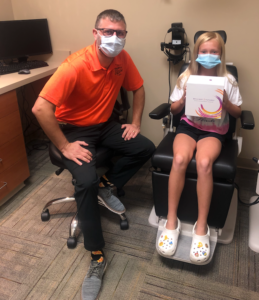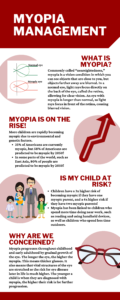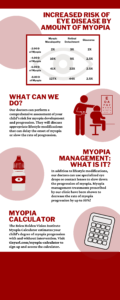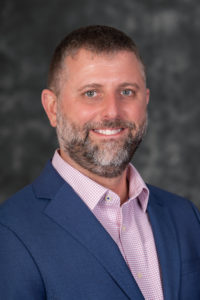April 15, 2022
By David Anderson, OD
If I could say anything to a doctor who might ask me what to do to better their practice, themselves, or their patients, my answer would be to start offering myopia management. This is the one thing.

Dr. Anderson’s first patient prescribed with MiSight 1 day contact lenses has only changed 0.25D in each eye in the last two years.
My experience with myopia management began around 2006 when a patient forced me to learn about it. A young girl and her mother had come into my office — the daughter was starting as a myope, and her mother was a high myope. At the end of the exam, I did my typical presentation offering the different contact lens and eyeglass options we could prescribe for the patient. Her mother asked me what we were going to do about stopping the disease.
When she said that, I stopped because I was unsure what she was talking about. She was of Asian descent and had recently moved to the United States. She explained that myopia was taken very seriously as a disease in Asia, and eye doctors were treating it as such, not just handing out prescriptions for glasses. After that conversation, I knew there was a lot of research to be done, and she had piqued my interest in considering myopia management as a legitimate part of my practice. I knew some options were available, but I didn’t know much about them. I was a newly minted optometrist at the time, and I saw this as an excellent opportunity to develop a practice specialty area I was passionate about. While I gave her daughter glasses for the interim, I spent months researching, and the modality I felt comfortable considering was orthokeratology. There were some published studies with atropine drops, but they were very limited. OrthoK was showing good promise, and I did a lot of research on it, and that’s what we came to as the treatment protocol.
That patient is now 25 years old, and she has been out of OrthoK for about four years. When I had first started treating her, she was a relatively high myope for her age at -2.25D. At her most recent exam, she was a -4.00D, but both of her parents were well over -10.00D, so the OrthoK did precisely what we wanted it to do.
Incorporating Other Myopia Management Treatment Options
My work with this patient led to a steady stream of OrthoK patients for several years, and I saw great success with these lenses. Because these were the early days of OrthoK, I received most of my information from journal articles — the majority of which didn’t even recognize the myopia management benefits of the lenses. I learned about the OrthoK technology from various companies and then learned about what the lenses do to the cornea and how it slows the growth of myopia through peripheral hyperopic defocus. I prescribed only OrthoK for myopia management for nearly a decade and saw great results from my patients.
It wasn’t until 2014 when a conversation with another patient had me seeking out other myopia management treatment options. A parent had expressed concern that her child wasn’t yet ready for the responsibility of OrthoK lenses, and she knew of eye drops that might be helpful. I again started researching and learning as much as I could about how low-dose atropine could work for children with myopia. I consulted with a nearby colleague who had been using atropine for her myopic patients for several years. At that point, I understood the concept and felt comfortable implementing it into my practice.
I prescribe a lot of OrthoK and prefer that modality because parents don’t worry about their kids losing a lens at school, and they can have better control over it. However, I now offer patients all three myopia management options: OrthoK, low-dose atropine, and soft multifocal contact lenses. I offer low-dose atropine in various concentrations, depending on the child’s response and any side effects they may have. I also use center-distance multifocal lenses from multiple companies. My preferred lens is CooperVision’s MiSight 1 day contact lenses because of the FDA approval and how their program is set up. It’s easier to explain to a parent that this isn’t just a product — it’s a process, and we can monitor their child’s progress within that program. I readily use all three treatment options, and I’m anxious to have some spectacle options, which I know are in the pipeline. Simply put, not everyone can wear contact lenses 100% of the time. We must have different options suited to various children’s needs and ensure that they’re still getting treatment even if they’re not feeling well or simply don’t want to wear contacts.
I want every patient and parent to know about and understand every treatment option. I let them know what I have the most experience with and what I feel the most comfortable with based on their child’s age and lifestyle, but I talk highly about each option and give each child one strong recommendation.
Starting Myopia Management Education Early
When I know patients have little kids — even babies — I start the conversation about myopia management. Parents must understand that we’re not just treating the blur anymore; instead, we’re treating the condition. I mention to them that they need to get their kids in for an exam as soon as possible because the earlier we can catch things, the better chance we have at achieving an overall positive result. I don’t want to see them when they’re already struggling to see the board in school or can’t read the clock. I want to see them when they’re close to plano and not already myopic.
In some cases, parents are all for it. They tell me how much sense it makes to start these exams and learn about the different options, and many parents are grateful they can do something for their child that wasn’t available to them. However, parents who aren’t nearsighted or aren’t severely nearsighted have more hesitations or don’t see the total value in what we’re offering.
 |
 |
Dr. Anderson provides this document — created by Dr. Taylor Sprague and Dr. Katie Connolly of IU School of Optometry — to educate parents myopia management. (click to enlarge)
It’s essential to be able to present something to parents to help them better understand what it is we’re trying to do with myopia management. Initially, I had no educational materials. Because of how frequently I was doing it, I eventually made a handout to give to parents, but it was very rudimentary, and it was mainly about the concept of OrthoK. There was very little on myopia management and its eye health effects. I knew what the research was showing, but nothing was widely accepted at that point. Now, we provide a handout to the parents — that’s the first part. We generally send it right to their patient portal so they can log in and access that, and then they have the opportunity to reach out and ask us any additional follow-up questions.
Taking the Leap with Myopia Management
As we move forward in this industry, I hope myopia management becomes common and expected. I hope that we can eliminate some of the most significant barriers to parents signing their kids up for myopia management — mainly the cost. The cost barrier comes from misunderstanding. Parents think they’re going to be spending money on one pair of glasses for their kids, and instead, they’re presented with a $2,000 myopia management program. They have never had to do it for themselves, so it’s a challenge to change their point of view on it. I hope that as more treatments receive FDA approval, more doctors embrace the technology and make it a regular part of their practice. These developments will make parents more accepting of myopia management.
If I could say anything to a doctor who might ask me what to do to better their practice, themselves, or their patients, my answer would be to start offering myopia management. This is the one thing. It’s not that hard to get started and make that conversion. It takes a little bit of understanding and the ability to adequately explain it to parents — just like how we do with anything else with our patients and how we can solve their vision needs. There are some fantastic things we can do for our myopic children, but this is the one thing that is a lifetime-changing event that we can be involved in and be heroes. And I think we should.
 |
Dr. Anderson is a graduate of The Ohio State University College of Optometry and has been a partner at Miamisburg Vision Care for nearly 20 years. Since becoming partner, he has more than tripled revenues, while operating a practice that has grown to include 20 staff and four doctors. He has shown the ability to manage at a high level during his tenure on the Board of the Ohio Optometric Association, while successfully passing several new laws to benefit Ohio Optometrists during his year as President of the OOA. He continues to serve on multiple committees at the state and national level, maintaining strong connections with leaders in all aspects of the industry. Now, he is taking his leadership experience and operations skill set to Optometric Management Group as Chief Operations Officer. |













